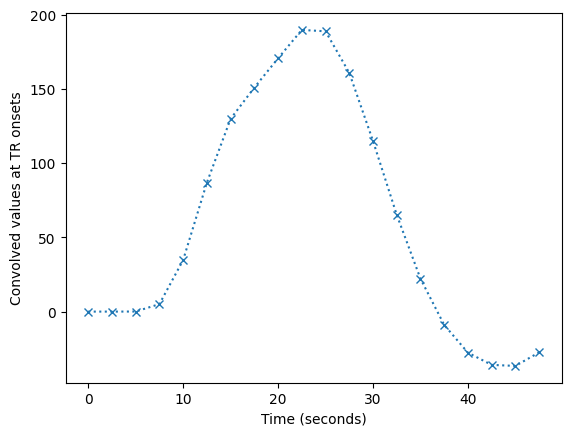Using onsets that do not start on a TR#
import numpy as np
import matplotlib.pyplot as plt
import nibabel as nib
Imagine we are analyzing our example image. It has a TR of 2.5, and 173 TRs.
TR = 2.5
n_trs = 173
The actual condition file for this dataset is ds114_sub009_t2r1_cond.txt.
# Load the function to fetch the data file we need.
import nipraxis
# Fetch the data file.
cond_fname = nipraxis.fetch_file('ds114_sub009_t2r1_cond.txt')
# Show the file name of the fetched data.
cond_fname
'/home/runner/.cache/nipraxis/0.5/ds114_sub009_t2r1_cond.txt'
You may remember it has a block design with blocks of length 12 TRs while the subject is doing the task.
What if we had a different event related condition file like the one at
new_cond.txt?
# Fetch the data file.
new_cond_fname = nipraxis.fetch_file('new_cond.txt')
# Show the file name of the fetched data.
new_cond_fname
Downloading file 'new_cond.txt' from 'https://raw.githubusercontent.com/nipraxis/nipraxis-data/0.5/new_cond.txt' to '/home/runner/.cache/nipraxis/0.5'.
'/home/runner/.cache/nipraxis/0.5/new_cond.txt'
cond_data = np.loadtxt(new_cond_fname)
cond_data
onsets_seconds = cond_data[:, 0]
durations_seconds = cond_data[:, 1]
amplitudes = cond_data[:, 2]
Notice that the onsets of the events can happen in the middle of the volumes (well after the volumes have started).
onsets_in_scans = onsets_seconds / TR
onsets_in_scans
array([ 1.34 , 5.104, 17.308, 30.1 , 38.192, 67.136, 112.944,
121.904, 142.528, 148.888])
Notice also that the events have amplitudes between 1 and 3. The events of amplitude 3 we expect to have an evoked brain response three times higher than events with amplitude 1.
What to do about the events with onsets that don’t exactly align with the start of the TRs (volumes)?
One option would be to round the event onsets to the nearest TR. This will mean that the event model will be different from our expected response by TR seconds / 2 == 1.25 seconds in this case.
Can we do better than that?
We could make a neural and hemodynamic regressor at a finer time resolution than the TRs, and later sample this regressor at the TR onset times.
This is what we do next.
tr_divs = 100.0 # finer resolution has 100 steps per TR
With each TR divided into 100 intervals, one element corresponds to time intervals of 1/100 of a TR:
high_res_times = np.arange(0, n_trs, 1 / tr_divs) * TR
We will soon create a new neural prediction time-course where one element corresponds to 1 / 100 of a TR:
high_res_neural = np.zeros(high_res_times.shape)
We have the onset indices in terms of TRs, but now we want the onset indices in terms of the new vector with 100 elements per TR:
high_res_onset_indices = onsets_in_scans * tr_divs
high_res_onset_indices
array([ 134. , 510.4, 1730.8, 3010. , 3819.2, 6713.6, 11294.4,
12190.4, 14252.8, 14888.8])
In the same way, the durations were in seconds. We divide by the TR to get
duration in terms of scans, then multiply by 100 to get the number in terms of
elements in the new high_res_neural time-course.
high_res_durations = durations_seconds / TR * tr_divs
high_res_durations
array([120., 120., 120., 120., 120., 120., 120., 120., 120., 120.])
Now we fill in the high_res_neural time course by setting values between
the start and the end of each event with the matching amplitudes:
for hr_onset, hr_duration, amplitude in zip(
high_res_onset_indices, high_res_durations, amplitudes):
hr_onset = int(round(hr_onset)) # index - must be int
hr_duration = int(round(hr_duration)) # makes index - must be int
high_res_neural[hr_onset:hr_onset + hr_duration] = amplitude
plt.plot(high_res_times, high_res_neural)
plt.xlabel('Time (seconds)')
plt.ylabel('High resolution neural prediction')
Text(0, 0.5, 'High resolution neural prediction')
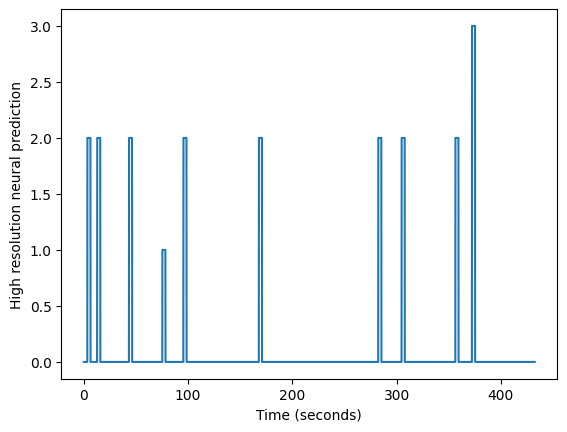
We can use the hemodynamic response function we created earlier:
from scipy.stats import gamma
def hrf(times):
""" Return values for HRF at given times """
# Gamma pdf for the peak
peak_values = gamma.pdf(times, 6)
# Gamma pdf for the undershoot
undershoot_values = gamma.pdf(times, 12)
# Combine them
values = peak_values - 0.35 * undershoot_values
# Scale max to 0.6
return values / np.max(values) * 0.6
We are going to convolve at this higher time resolution. First we need to sample the HRF at this finer time resolution, to match the neural prediction:
hrf_times = np.arange(0, 24, 1 / tr_divs)
hrf_at_hr = hrf(hrf_times)
Next we convolve the sampled HRF with the high resolution neural time course:
high_res_hemo = np.convolve(high_res_neural, hrf_at_hr)
# Drop tail from convolution
high_res_hemo = high_res_hemo[:len(high_res_neural)]
plt.plot(high_res_times, high_res_hemo)
plt.xlabel('Time (seconds)')
plt.ylabel('High resolution convolved values')
len(high_res_times)
17300
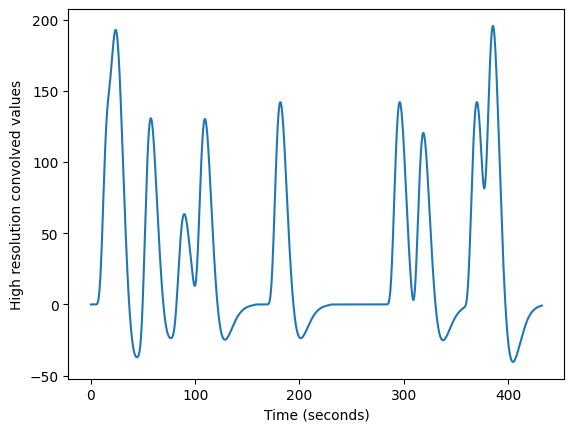
We can see that this is sampled at high resolution on the x axis by looking at the first 20 TRs-worth of data:
top_index = int(20 * tr_divs)
plt.plot(high_res_times[:top_index], high_res_hemo[:top_index], 'x:')
[<matplotlib.lines.Line2D at 0x7fe0a7fdbc40>]
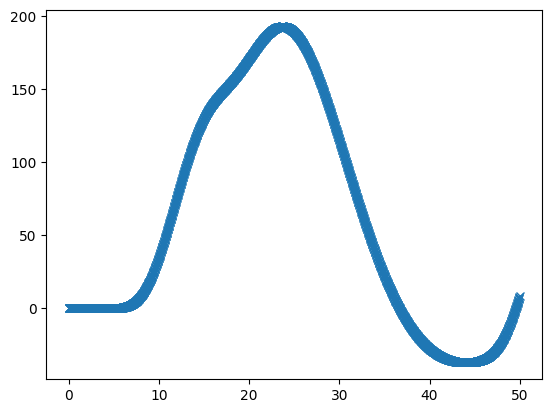
We can then subsample this high-resolution time course to get the values corresponding to the start of each original TR (volume):
tr_indices = np.arange(n_trs)
hr_tr_indices = np.round(tr_indices * tr_divs).astype(int)
tr_hemo = high_res_hemo[hr_tr_indices]
tr_times = tr_indices * TR # times of TR onsets in seconds
plt.plot(tr_times, tr_hemo)
plt.xlabel('Time (seconds)')
plt.ylabel('Convolved values at TR onsets')
Text(0, 0.5, 'Convolved values at TR onsets')
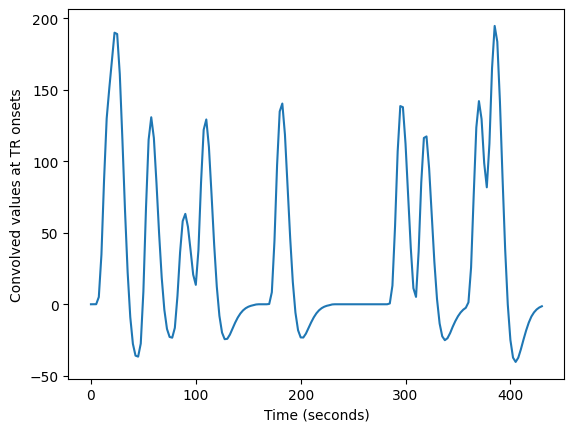
The first 20 TRs-worth of data shows these values are sampled every TR rather than every 1/100th of a TR:
plt.plot(tr_times[:20], tr_hemo[:20], 'x:')
plt.xlabel('Time (seconds)')
plt.ylabel('Convolved values at TR onsets')
Text(0, 0.5, 'Convolved values at TR onsets')
